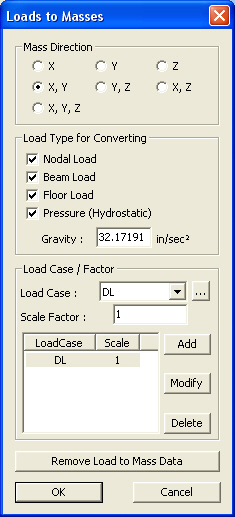Loads to Masses
| ||
|
| ||
|
| ||
|
Convert the values of the vertical components of the entered loads (loads acting in GCS (-)Z-direction) to masses and enter them as lumped mass data.
Note This function does not convert self-weight into masses. In order to convert self-weight into masses, "Converting Type of Model Weight to Masses" in Model>Structure Type can be used. | ||
|
| ||
|
| ||
|
| ||
|
From the Main Menu select Model > Masses > Loads to Masses.
Select Geometry > Masses > Loads to Masses in the Menu tab of the Tree Menu. | ||
|
| ||
|
| ||
Note 1 The general methods of converting the structure and the loads into masses are as follows:
1.Self-weight of the structure Converting Type of Model Weight to Masses in Model>Structure Type 2. Loads applied to the structure Model>Masses>Load to Masses
Note 2 It is common to convert the structure and loads into lumped masses in case of building structures.
Note 3 The converted masses from the structure and the loads can be checked from Query>Mass Summary Table.
| ||
|
|
